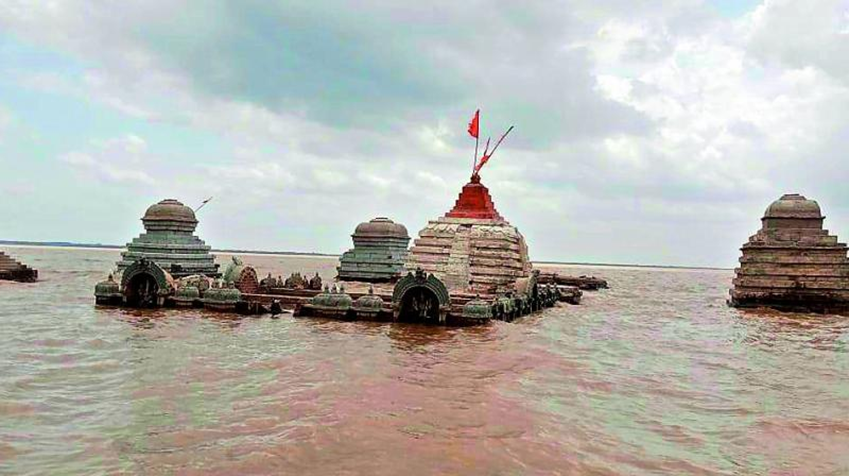- Courses
- GS Full Course 1 Year
- GS Full Course 2 Year
- GS Full Course 3 Year
- GS Full Course Till Selection
- Online Program
- GS Recorded Course
- NCERT (Recorded 500+ Hours)
- Polity Recorded Course
- Geography Recorded Course
- Economy Recorded Course
- AMAC Recorded Course
- Modern India, Post Independence & World History
- Environment Recoded Course
- Governance Recoded Course
- Science & Tech. Recoded Course
- International Relations and Internal Security Recorded Course
- Disaster Management Module Course
- Ethics Recoded Course
- Essay Recoded Course
- Current Affairs Recoded Course
- CSAT
- 5 LAYERED ARJUNA Mentorship
- Public Administration Optional
- ABOUT US
- OUR TOPPERS
- TEST SERIES
- FREE STUDY MATERIAL
- VIDEOS
- CONTACT US
Andhra Pradesh - Ancient Temple Submerged by Krishna Waters
Andhra Pradesh - Ancient Temple Submerged by Krishna Waters
27-07-2024

In a recurring phenomenon since 2003, the ancient Sangameshwara temple, located at the confluence of seven tributaries near Muchumarri in Kurnool district, Andhra Pradesh, has once again been submerged by floodwaters.
- This annual event is a result of heavy rains in the upstream areas, which lead to the release of water from various projects in Maharashtra, Karnataka, Telangana, and Kurnool district.
- Despite the temple being inundated, the religious rituals continue uninterrupted. On July 20, priests braved the rains and swirling waters, using a boat to perform special rituals near the submerged temple.
- The Sangameshwara temple, originally built in 740 AD by Chalukya ruler Pulakesi II, was dismantled and reconstructed at its current site in 1979 due to the construction of the Srisailam Dam.
- This temple holds significant architectural and religious importance, with its intricate carvings and historical inscriptions.
- The submergence of the temple serves as a reminder of the impact of upstream water management and the resilience of cultural and religious practices in the face of natural events.
About Sangameshwara Temple:
- Location: Nandyal district, Andhra Pradesh.
- Proximity: Situated near Muchumarri at the confluence of the Krishna and Bhavanasi rivers.
- Construction: Built in 740 AD by Chalukya ruler Pulakesi II.
- Dismantled and reconstructed rock-to-rock at its current site in 1979 due to the Srisailam Dam construction.
Architectural Features:
- Style: Built in Nagara style on an elevated platform with a fortified wall.
- Structure: Features a large hall with 12 pillars.
- Includes a sanctum and a circumambulatory path.
- Carvings: Ceiling relief of Nagaraja. Pillars have carvings of Lord Vishnu, Brahma, Kumaraswamy, and celestial figures.
- Outer wall carvings include Ardhanareeswara, Ganesha, Siva killing demon, Harihara, Manmadha, Yama, and Shiva with 18 hands.
- Carvings of crocodiles with human figures inside at all four corners.
- Outer walls have beautifully carved Toranas and lattice windows.
Additional Features:
- Shrines: Small shrine of Lord Venkateswara near the main entrance.
- Mandapa: Large Nandi mandapa opposite the temple.
- Inscriptions: Several inscriptions on the temple pillars and a pillar near the Nandi mandapa.
Religious Significance:
- Lingam: The temple's wooden Lingam, Sangameshwaram, is believed to have been installed by Dharmaraja, a Pandava, after visiting Srisailam Mallikarjuna temple.
Current Situation:
- Submergence: The temple gets submerged annually due to heavy rains and the release of water from upstream projects.
- Rituals: Despite the submergence, priests continue to perform special rituals, often braving rains and swirling waters by boat.
Impact of Upstream Projects:
- Water Release: Several projects in Maharashtra, Karnataka, Telangana, and Kurnool district are brimming to full capacity due to heavy rains.
- Floodwaters: The release of water from these projects leads to rising water levels at the Srisailam project, causing floodwaters to enter the Sangameshwara temple.
Conclusion:
The annual submergence of the Sangameshwara temple highlights the impact of upstream water management and the resilience of religious practices in the face of natural events. These notes provide a comprehensive overview of the current situation, historical context, architectural significance, and religious importance of the Sangameshwara temple in Andhra Pradesh.
Must Check: Best IAS Coaching In Delhi
UPSC Prelims Result 2024 Out: Expected Cut Off & Other Details, UPSC Prelims 2024 Answer with Explanation, Daily Prelims Quiz, Daily Current Affairs, MONTHLY CURRENT AFFAIRS TOTAL (CAT) MAGAZINE, Best IAS Coaching Institute in Karol Bagh, Best IAS Coaching Institute in Delhi, Daily Mains Question Answer Practice, ENSURE IAS UPSC Toppers, UPSC Toppers Marksheet, Previous Year Interview Questions, UPSC Syllabus
PLFS 2025: Monthly Jobs Data, Bigger Survey
PLFS 2025: Monthly Jobs Data, Bigger Survey


